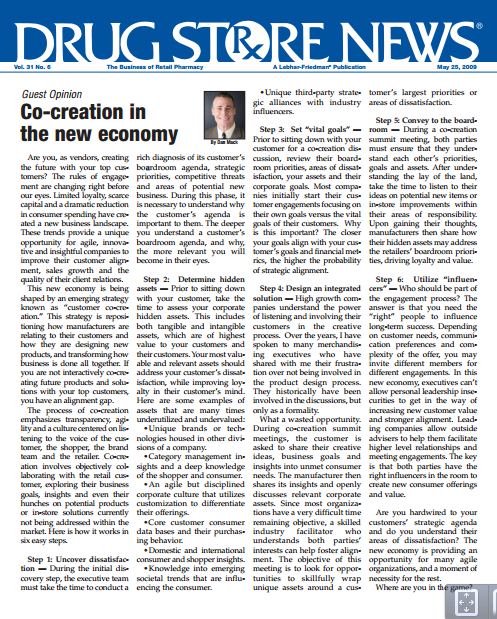
Drug Store News
Are you, as vendors, creating the future with your top customers? The rules of engagement are changing right before our eyes. Limited loyalty, scarce capital and a dramatic reduction in consumer spending have created a new business landscape. These trends provide a unique opportunity for agile, innovative and insightful companies to improve their customer alignment, sales growth and the quality of their client relations.
This new economy is being shaped by an emerging strategy known as “customer co-creation.” This strategy is repositioning how manufacturers are relating to their customers and how they are designing new products, and transforming how business is done all together. If you are not interactively co-creating future products and solutions with your top customers, you have an alignment gap.
The process of co-creation emphasizes transparency, agility and a culture centered on listening to the voice of the customer, the shopper, the brand team and the retailer. Co-creation involves objectively collaborating with the retail customer, exploring their business goals, insights and even their hunches on potential products or in-store solutions currently not being addressed within the market. Here is how it works in six easy steps.
Step 1: Uncover dissatisfaction — During the initial discovery step, the executive team must take the time to conduct a rich diagnosis of its customer’s boardroom agenda, strategic priorities, competitive threats and areas of potential new business. During this phase, it is necessary to understand why the customer’s agenda is important to them. The deeper you understand a customer’s boardroom agenda, and why, the more relevant you will become in their eyes.
Step 2: Determine hidden assets — Prior to sitting down with your customer, take the time to assess your corporate hidden assets. This includes both tangible and intangible assets, which are of highest value to your customers and their customers. Your most valuable and relevant assets should address your customer’s dissatisfaction, while improving loyalty in their customer’s mind. Here are some examples of assets that are many times underutilized and undervalued:
- Unique brands or technologies housed in other divisions of a company.
- Category management insights and a deep knowledge of the shopper and consumer.
- An agile but disciplined corporate culture that utilizes customization to differentiate their offerings. •Core customer consumer data bases and their purchasing behavior.
- Domestic and international consumer and shopper insights.
- Knowledge into emerging societal trends that are influencing the consumer.
- Unique third-party strategic alliances with industry influencers.
Step 3: Set “vital goals” —Prior to sitting down with your customer for a co-creation discussion, review their boardroom priorities, areas of dissatisfaction, your assets and their corporate goals. Most companies initially start their customer engagements focusing on their own goals versus the vital goals of their customers. Why is this important? The closer your goals align with your customer’s goals and financial metrics, the higher the probability of strategic alignment.
Step 4: Design an integrated solution — High growth companies understand the power of listening and involving their customers in the creative process. Over the years, I have spoken to many merchandising executives who have shared with me their frustration over not being involved in the product design process. They historically have been involved in the discussions, but only as a formality.
What a wasted opportunity. During co-creation summit meetings, the customer is asked to share their creative ideas, business goals and insights into unmet consumer needs. The manufacturer then shares its insights and openly discusses relevant corporate assets. Since most organizations have a very difficult time remaining objective, a skilled industry facilitator who understands both parties’ interests can help foster alignment. The objective of this meeting is to look for opportunities to skillfully wrap unique assets around a customer’s largest priorities or areas of dissatisfaction.
Step 5: Convey to the boardroom — During a co-creation summit meeting, both parties must ensure that they understand each other’s priorities, goals and assets. After understanding the lay of the land, take the time to listen to their ideas on potential new items or in-store improvements within their areas of responsibility. Upon gaining their thoughts, manufacturers then share how their hidden assets may address the retailers’ boardroom priorities, driving loyalty and value.
Step 6: Utilize “influencers” — Who should be part of the engagement process? The answer is that you need the “right” people to influence long-term success. Depending on customer needs, communication preferences and complexity of the offer, you may invite different members for different engagements. In this new economy, executives can’t allow personal leadership insecurities to get in the way of increasing new customer value and stronger alignment. Leading companies allow outside advisers to help them facilitate higher level relationships and meeting engagements. The key is that both parties have the right influencers in the room to create new consumer offerings and value. Are you hardwired to your customers’ strategic agenda and do you understand their areas of dissatisfaction? The new economy is providing an opportunity for many agile organizations, and a moment of necessity for the rest. Where are you in the game?[/vc_column_text][/vc_column][/vc_row]

